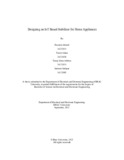| dc.contributor.advisor | Huda, A. S. Nazmul | |
| dc.contributor.author | Ahmed, Hasnain | |
| dc.contributor.author | Jahan, Tanvir | |
| dc.contributor.author | Adittya, Tareq Islam | |
| dc.contributor.author | Sadique, Sadman | |
| dc.date.accessioned | 2022-01-17T05:47:10Z | |
| dc.date.available | 2022-01-17T05:47:10Z | |
| dc.date.copyright | 2021 | |
| dc.date.issued | 2021-09 | |
| dc.identifier.other | ID 16221015 | |
| dc.identifier.other | ID 16321030 | |
| dc.identifier.other | ID 16121015 | |
| dc.identifier.other | ID 16121093 | |
| dc.identifier.uri | http://hdl.handle.net/10361/15942 | |
| dc.description | This thesis is submitted in partial fulfillment of the requirements for the degree of Bachelor of Science in Electrical and Electronic Engineering, 2021. | en_US |
| dc.description | Cataloged from PDF version of thesis. | |
| dc.description | Includes bibliographical references (pages 42-44). | |
| dc.description.abstract | A voltage stabilizer is a device that detects and corrects abnormal voltage levels in order to
create a sufficiently steady output where the load is attached. The goal of this project is to build
and construct an automated high-performance voltage stabilizer that can identify and adjust
incorrect voltage levels to provide a sufficiently steady output as well as monitoring the output
voltage wirelessly through NodeMCU microcontroller unit and Blynk mobile application. The
system is comprised of five interdependent architectural designs: power supply, voltage
regulator, monitoring circuit (NodeMCU), and step up transformer, which provides the needed
signal when activated by a relay driver to illuminate the bulb. The relay contacts are suitably
integrated to the transformer taps to carry out the aforementioned operations in accordance
with the directions provided by the BJT (Bipolar Junction Transistor) output. The proposed
circuit works well and the results are good. When installed, the relay trips whenever the input
voltage exceeds 250 volts, lowering the output voltage to 220 volts and holding it there
constantly. When the voltage is fixed at 220 volts, the relay de-energize while pulling the
voltage to approximately 240 volts and retaining the difference when the voltage falls further.
The preceding operation maintains the appliance's output voltage between 220 volts constantly,
with variations ranging from 140 to 250 volts. | en_US |
| dc.description.statementofresponsibility | Hasnain Ahmed | |
| dc.description.statementofresponsibility | Tanvir Jahan | |
| dc.description.statementofresponsibility | Tareq Islam Adittya | |
| dc.description.statementofresponsibility | Sadman Sadique | |
| dc.format.extent | 44 pages | |
| dc.language.iso | en | en_US |
| dc.publisher | Brac University | en_US |
| dc.rights | Brac University theses are protected by copyright. They may be viewed from this source for any purpose, but reproduction or distribution in any format is prohibited without written permission. | |
| dc.subject | NodeMCU | en_US |
| dc.subject | Relay driver | en_US |
| dc.subject | BJT | en_US |
| dc.subject | Power supply | en_US |
| dc.subject | Step-Up transformer | en_US |
| dc.subject | Voltage regulator | en_US |
| dc.subject.lcsh | Internet of Things | |
| dc.subject.lcsh | Artificial intelligence | |
| dc.title | Designing an IoT based stabilizer for home appliances | en_US |
| dc.type | Thesis | en_US |
| dc.contributor.department | Department of Electrical and Electronic Engineering, Brac University | |
| dc.description.degree | B. Electrical and Electronic Engineering | |

